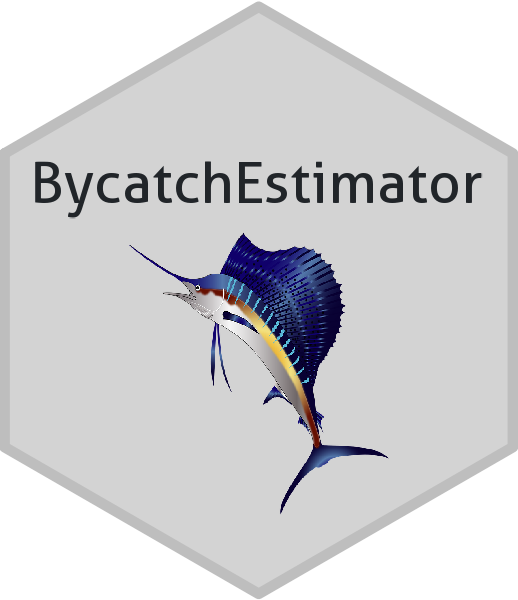BycatchEstimator is used to estimate both total bycatch, calculated by expanding a sample, such as an observer database, to total effort from logbooks or landings records, and an annual index of abundance, calculated only from the observer data.
BycatchEstimator uses both model-based and design-based procedures to estimate total annual bycatch by expanding a sample, such as an observer database, in relation to total effort from logbooks or landings records. The model framework can also be used to estimate an annual index of abundance, calculated only from the observer data. Using this tool, bycatch estimation is carried out by running linear models based on user-defined statistical distributions of observation error models (e.g. delta-lognormal, and negative binomial) with predictor variables (e.g., year, season, depth). The task of identifying a best approximating model is addressed through a semi-automated model selection process based on the user’s choice of information criteria (AICc, AIC or BIC) and cross validation. Once a best approximating model is identified, the standardized CPUE model is used to predict total bycatch in all logbook trips and summing across trips. Design-based estimates are made using a ratio estimator or a delta-lognormal estimator with stratification variables specified by the user. This bycatch estimation tool has been developed as an accessible R package. See the User’s Guide under articles at https://ebabcock.github.io/BycatchEstimator/ for details.
The code runs best in R studio. Before running the code for the first time, install the latest versions of R and RStudio. The output figures and tables are printed to a pdf file using R Markdown and the knitr library, which outputs a LaTex file; therefore, you must have a LaTex program installed, such as TinyTex (https://yihui.org/tinytex/).
You can install the development version of BycatchEstimator from GitHub with:
# install.packages("devtools")
devtools::install_github("ebabcock/BycatchEstimator")For more help with installation, see the Installation Guide https://ebabcock.github.io/BycatchEstimator/articles/InstallationGuide.html Also, see the video tutorial at https://miami.box.com/s/sjqwj3c1v1tcv4y3n169u3x5bs18rir2
Due to a complication in coding, the user must load library(MuMIn) in
addition to library(BycatchEstimator).
library(BycatchEstimator)
library(MuMIn)To demonstrate its use, example data sets are included in this R package. In this example, we will use data sets from LLSIM (Goodyear 2021).
Simulation of longline fleets with LLSIM was conducted using three idealized fleets as described by Goodyear (2021). These fleets are a USA-like fleet (fleet 1), Japan-like fleet (fleet 2) and a Brazil-like fleet (fleet 3). The simulated data set included three fleets, with data spanning from 1990 to 2018 to reflect the approximate period for which observer coverage has been established. The species distribution model (SDM) and longline simulator generates a 3-dimensional distribution of blue marlin and swordfish throughout the Atlantic Ocean based on the habitat preferences of the species. Simulated longline sets are then generated by distributing hooks throughout the habitat of the species, consistent with the distribution, gear, hooks between floats, use of lightsticks and other characteristics of historical longline fishing fleets. While LLSIM initially produces set-level catches, both logbooks and observer databases were allocated by trip (Babcock and Goodyear 2021). Sets are allocated to trip if they were in the same gear, month and spatial area (5 x 5 squares). Trips with more than 100 sets were randomly allocated to different trips so that the median trips had about 20 sets.
LLSIM_BUM_Example_logbookObserver program data are generated by passing the trip-level logbook data to an observer program sub-model. The observer sub-model assumes that observer coverage is randomly assigned to trips, with 5% coverage of trips. The entire trip is assumed to be observed.
LLSIM_BUM_Example_observerThe first step in bycatch estimation is setup the input file and review
and verify the data. Notice that returned value from bycatchSetup is
assigned as an object that will be used in a subsequent step. This step
also produces output that is saved to the working directory for the user
to review. Review is essential to ensure that data have been correctly
formatted and interpreted in model setup.
setupObj<-bycatchSetup(
modelTry = c("TMBnbinom1","TMBtweedie"),
obsdat = droplevels(LLSIM_BUM_Example_observer[LLSIM_BUM_Example_observer$Year>2010 &LLSIM_BUM_Example_observer$fleet==2,]),
logdat = droplevels(LLSIM_BUM_Example_logbook[LLSIM_BUM_Example_logbook$Year>2010 & LLSIM_BUM_Example_logbook$fleet==2,]),
yearVar = "Year",
obsEffort = "hooks",
logEffort = "hooks",
logUnsampledEffort = "unsampledEffort",
includeObsCatch = TRUE,
matchColumn = "trip",
factorNames = c("Year","area"),
randomEffects= NULL,
randomEffects2= NULL,
EstimateIndex = TRUE,
EstimateBycatch = TRUE,
logNum = NA,
sampleUnit = "trips",
complexModel = formula(y~Year+area),
simpleModel = formula(y~Year),
indexModel = formula(y~Year),
designMethods =c("Ratio","Delta"),
designVars=c("Year","area"),
designPooling = FALSE,
minStrataUnit=1,
baseDir = getwd(),
runName = "LLSIMBUMtripExample",
runDescription = "LLSIm BUM by trip, with 5% observer coverage including observed catch in totals",
common = c("Swordfish","Blue marlin")[2],
sp = c("Xiphias gladius","Makaira nigricans")[2],
obsCatch = c("SWO","BUM")[2],
catchUnit = "number",
catchType = "catch"
)The output produced in step one includes the object returned by
bycatchSetup. The naming convention for this object ends
_BycatchModelSpecification.rds, as shown below. Thus, any model setup
can be stored and later retrieved for analysis.
setupObj<-readRDS(file=paste0(getwd(), paste("/Output", "LLSIMBUMtripExample"),"/", Sys.Date(),"_BycatchModelSpecification.rds"))Estimation of bycatch and/or index of abundance is carried out by using
the function bycatchFit. This function requires an object produced by
bycatchSetup as well as several other arguments.
bycatchFit(
setupObj = setupObj,
selectCriteria = "BIC",
DoCrossValidation = FALSE,
DredgeCrossValidation = FALSE,
ResidualTest = FALSE,
CIval = 0.05,
VarCalc = "None",
useParallel = TRUE,
nSims = 1000,
baseDir = getwd(),
plotValidation = FALSE,
trueVals = NULL,
trueCols = NULL,
doReport = TRUE
)Goodyear, C.P. 2021. Development of new model fisheries for simulating longline catch data with LLSIM. Collect. Vol. Sci. Pap. ICCAT, 78(5): 53-62
Babcock, E.A. and C. P. Goodyear. 2021. Testing a bycatch estimation tool using simulated blue marlin longline data. ICCAT Collective Volume of Scientific Papers, 78(5): 179-189.
Babcock E. A., W. J. Harford, T. Gedamke, D. Soto, and C. P. Goodyear. 2022. Efficacy of a bycatch estimation tool. ICCAT Collective Volume of Scientific Papers 79(5): 304-339
